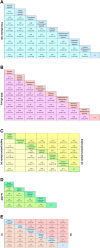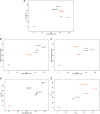Efficacy and safety of eight types Salvia miltiorrhiza injections in the treatment of unstable angina pectoris: A network meta-analysis
- PMID: 36263128
- PMCID: PMC9574204
- DOI: 10.3389/fphar.2022.972738
Efficacy and safety of eight types Salvia miltiorrhiza injections in the treatment of unstable angina pectoris: A network meta-analysis
Abstract
Background: Salvia miltiorrhiza Bunge. [Lamiaceae, danshen] injection classes (SMIC) is widely used in the treatment of unstable angina (UA). However, it is uncertain which SMIC is more effective in terms of UA efficacy. The purpose of this Network Meta-analysis (NMA) was to compare the treatment effects of various SMIC to determine the best SMIC for the treatment of UA. Methods: The China National Knowledge Infrastructure (CNKI), Wanfang Database, China Science and Technology Journal Database (VIP), Chinese Biomedical Literature Database (CBM), PubMed, Web of Science, and Cochrane Library databases were searched to screen randomized controlled trials (RCTs) of SMIC for UA. The search time frame was all from the establishment of the database to May 2022. RevMan 5.3 and Stata 14.0 software were used for NMA. Results: A total of 148 studies including 14,979 patients, including 7,584 cases in the experimental group and 7,395 cases in the control group were included, and eight SMIC were extracted, namely:Danshen injection, Fufang Danshen injection, Guanxinning injection, Danshenchuanxiongqin injection, Danhong injection, Danshentong IIA Huangsuanna injection, Shenxiong Putaotang injection, and Danshenduofensuanyan injection. The results of NMA showed that, in terms of total effective rate, Shenxiong Putaotang injection and Danshenchuanxiongqin injection have the advantage; In terms of ECG efficiency, Danshentong IIA Huangsuanna injection and Danshen injection have an advantage; Danshenchuanxiongqin injection and Danshenduofensuanyan injection were more effective than other SMIC in improving angina pectoris attacks; Shenxiong Putaotang injection has an advantage in improving hs-CRP; Shenxiong Putaotang injection and Danshentong IIA Huangsuanna injection have advantages in improving TC and TG, respectively. Conclusion: The eight SMIC included in the current study were effective in treating UA, Shenxiong Putaotang injection and Danshentong IIA Huangsuanna injection were both superior in improving all outcome indicators. However, there is still a need for larger samples and high-quality randomized controlled trials for more refined comparisons of various SMIC. Systematic Review Registration: [PROSPERO], identifier [CRD42022350872].
Keywords: Chinese medicine injection; Salvia miltiorrhiza injection classes; Traditional Chinese Medicine; network meta-analysis; unstable angina (UA).
Copyright © 2022 Li, Li, Liu, Lai and Xing.
Conflict of interest statement
The authors declare that the research was conducted in the absence of any commercial or financial relationships that could be construed as a potential conflict of interest.
Figures








Similar articles
-
Efficacy and safety of danshen class injections in the treatment of coronary heart disease: a network meta-analysis.Front Pharmacol. 2024 Dec 12;15:1487119. doi: 10.3389/fphar.2024.1487119. eCollection 2024. Front Pharmacol. 2024. PMID: 39726778 Free PMC article. Review.
-
[Network Meta-analysis of Chinese medicine injection combined with conventional western medicine in treatment of stable angina pectoris].Zhongguo Zhong Yao Za Zhi. 2023 Mar;48(6):1652-1663. doi: 10.19540/j.cnki.cjcmm.20220907.503. Zhongguo Zhong Yao Za Zhi. 2023. PMID: 37005853 Chinese.
-
[Network Meta-analysis of Chinese medicine injections for activating blood and resolving stasis in adjuvant treatment of acute ischemic stroke].Zhongguo Zhong Yao Za Zhi. 2023 Aug;48(15):4215-4230. doi: 10.19540/j.cnki.cjcmm.20230425.501. Zhongguo Zhong Yao Za Zhi. 2023. PMID: 37802790 Chinese.
-
Effectiveness and safety of Danshen injections in treatment of cardiac failure: a network meta-analysis.Front Pharmacol. 2024 Mar 13;15:1319551. doi: 10.3389/fphar.2024.1319551. eCollection 2024. Front Pharmacol. 2024. PMID: 38545554 Free PMC article. Review.
-
Efficacy of Chinese Medicine Injection for Cardiotoxic Injury of Anthracycline Chemotherapy Drugs: A Network Meta-Analysis of Randomized Controlled Trials.Evid Based Complement Alternat Med. 2022 Mar 31;2022:5800575. doi: 10.1155/2022/5800575. eCollection 2022. Evid Based Complement Alternat Med. 2022. Retraction in: Evid Based Complement Alternat Med. 2023 Oct 11;2023:9856061. doi: 10.1155/2023/9856061. PMID: 35399632 Free PMC article. Retracted. Review.
Cited by
-
Danshen injection ameliorates unilateral ureteral obstruction-induced renal fibrosis by inhibiting ferroptosis via activating SIRT1/GPX4 pathway.Front Pharmacol. 2025 Jan 13;15:1503628. doi: 10.3389/fphar.2024.1503628. eCollection 2024. Front Pharmacol. 2025. PMID: 39872048 Free PMC article.
-
Editorial: Emerging contaminants and their effect on agricultural crops.Front Plant Sci. 2023 Oct 24;14:1296252. doi: 10.3389/fpls.2023.1296252. eCollection 2023. Front Plant Sci. 2023. PMID: 37941663 Free PMC article. No abstract available.
-
Effectiveness and safety of selected traditional Chinese medicine injections in patients with combined diabetes mellitus and coronary heart disease: A systematic review and network meta-analysis of randomized clinical trials.Front Pharmacol. 2023 Jan 9;13:1060956. doi: 10.3389/fphar.2022.1060956. eCollection 2022. Front Pharmacol. 2023. PMID: 36699083 Free PMC article.
-
Tanshinone IIA Inhibits the Endoplasmic Reticulum Stress-Induced Unfolded Protein Response by Activating the PPARα/FGF21 Axis to Ameliorate Nonalcoholic Steatohepatitis.Antioxidants (Basel). 2024 Aug 23;13(9):1026. doi: 10.3390/antiox13091026. Antioxidants (Basel). 2024. PMID: 39334685 Free PMC article.
-
Molecular targets and mechanisms of Guanxinning tablet in treating atherosclerosis: Network pharmacology and molecular docking analysis.Medicine (Baltimore). 2023 Sep 29;102(39):e35106. doi: 10.1097/MD.0000000000035106. Medicine (Baltimore). 2023. PMID: 37773840 Free PMC article.
References
-
- Amsterdam E. A., Wenger N. K., Brindis R. G., Casey D. E., Ganiats T. G., Holmes D. R., et al. (2014). 2014 AHA/ACC guideline for the management of patients with non-ST-elevation acute coronary syndromes: Executive summary: A report of the American college of cardiology/American heart association task force on practice guidelines. Circulation 130 (25), 2354–2394. 10.1161/CIR.0000000000000133 PubMed Abstract | 10.1161/CIR.0000000000000133 | Google Scholar - DOI - DOI - PubMed
-
- An Y. Q. (2010). Efficacy of Danhong injection in the treatment of unstable angina pectoris. China Pract. Med. 5 (26), 174–175. Google Scholar
-
- Bian Z. Q. (2015). Clinical analysis of 98 cases of unstable angina pectoris treated with Danhong injection. China Pharm. Sci. 05 (18), 119–121. Google Scholar
-
- Braunwald E., Antman E. M., Beasley J. W., Califf R. M., Cheitlin M. D., Hochman J. S., et al. (2000). ACC/AHA guidelines for the management of patients with unstable angina and non-STsegment elevation myocardial infarction. A report of the American college of cardiology/American heart association task force on practice guidelines (committee on the management of patients with unstable Angina). J. Am. Coll. Cardiol. 36, 970–1062. 10.1016/s0735-1097(00)00889-5 PubMed Abstract | 10.1016/s0735-1097(00)00889-5 | Google Scholar - DOI - DOI - PubMed
-
- Braunwald E., Morrow D. A. (2013). Unstable angina, is it time for a requiem? Circulation 127, 2452–2457. 10.1161/CIRCULATIONAHA.113.001258 PubMed Abstract | 10.1161/CIRCULATIONAHA.113.001258 | Google Scholar - DOI - DOI - PubMed
Publication types
LinkOut - more resources
Full Text Sources
Research Materials
Miscellaneous

